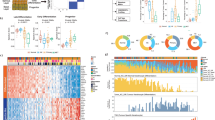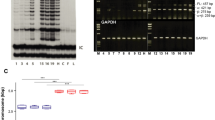Abstract
Mice of the C57BL/6 strain are resistant to the development of skin squamous carcinomas (SCCs) induced by an activated Ras oncogene, whereas FVB/N mice are highly susceptible1. The genetic basis of this difference in phenotype is unknown. Here we show that susceptibility to SCC is under the control of a carboxy-terminal polymorphism in the mouse Ptch gene. F1 hybrids between C57BL/6 and FVB/N strains ((B6FVB)F1) are resistant to Ras-induced SCCs, but resistance can be overcome either by elimination of the C57BL/6 Ptch allele (PtchB6) or by overexpression of the FVB/N Ptch allele (PtchFVB) in the epidermis of K5Hras-transgenic (B6FVB)F1 hybrid mice. The human Patched (PTCH) gene is a classical tumour suppressor gene for basal cell carcinomas and medulloblastomas, the loss of which causes increased signalling through the Sonic Hedgehog (SHH) pathway2,3,4,5. SCCs that develop in PtchB6+/- mice do not lose the wild-type Ptch gene or show evidence of increased SHH signalling. Although PtchFVB overexpression can promote SCC formation, continued expression is not required for tumour maintenance, suggesting a role at an early stage of tumour cell lineage commitment. The Ptch polymorphism affects Hras-induced apoptosis, and binding to Tid1, the mouse homologue of the Drosophila l(2)tid tumour suppressor gene. We propose that Ptch occupies a critical niche in determining basal or squamous cell lineage, and that both tumour types can arise from the same target cell depending on carcinogen exposure and host genetic background.
This is a preview of subscription content, access via your institution
Access options
Subscribe to this journal
Receive 51 print issues and online access
$199.00 per year
only $3.90 per issue
Buy this article
- Purchase on Springer Link
- Instant access to full article PDF
Prices may be subject to local taxes which are calculated during checkout




Similar content being viewed by others
References
Hennings, H. et al. FVB/N mice: an inbred strain sensitive to the chemical induction of squamous cell carcinomas in the skin. Carcinogenesis 14, 2353–2358 (1993)
Hahn, H. et al. Mutations of the human homolog of Drosophila patched in the nevoid basal cell carcinoma syndrome. Cell 85, 841–851 (1996)
Johnson, R. L. et al. Human homolog of patched, a candidate gene for the basal cell nevus syndrome. Science 272, 1668–1671 (1996)
Gailani, M. R. et al. The role of the human homologue of Drosophila patched in sporadic basal cell carcinomas. Nature Genet. 14, 78–81 (1996)
Dahmane, N., Lee, J., Robins, P., Heller, P. & Ruiz i Altaba, A. Activation of the transcription factor Gli1 and the Sonic hedgehog signalling pathway in skin tumours. Nature 389, 876–881 (1997)
Brown, K., Strathdee, D., Bryson, S., Lambie, W. & Balmain, A. The malignant capacity of skin tumours induced by expression of a mutant H-ras transgene depends on the cell type targeted. Curr. Biol. 8, 516–524 (1998)
Li, X. et al. Ex vivo culture of Fancc-/- stem/progenitor cells predisposes cells to undergo apoptosis, and surviving stem/progenitor cells display cytogenetic abnormalities and an increased risk of malignancy. Blood 105, 3465–3471 (2005)
Aszterbaum, M. et al. Ultraviolet and ionizing radiation enhance the growth of BCCs and trichoblastomas in patched heterozygous knockout mice. Nature Med. 5, 1285–1291 (1999)
Unden, A. B. et al. Mutations in the human homologue of Drosophila patched (PTCH) in basal cell carcinomas and the Gorlin syndrome: different in vivo mechanisms of PTCH inactivation. Cancer Res. 56, 4562–4565 (1996)
Arbeit, J. M., Munger, K., Howley, P. M. & Hanahan, D. Progressive squamous epithelial neoplasia in K14-human papillomavirus type 16 transgenic mice. J. Virol. 68, 4358–4368 (1994)
Chin, L. et al. Essential role for oncogenic Ras in tumour maintenance. Nature 400, 468–472 (1999)
Weinstein, I. B. Cancer. Addiction to oncogenes—the Achilles heal of cancer. Science 297, 63–64 (2002)
Thibert, C. et al. Inhibition of neuroepithelial patched-induced apoptosis by sonic hedgehog. Science 301, 843–846 (2003)
Barnes, E. A., Kong, M., Ollendorff, V. & Donoghue, D. J. Patched1 interacts with cyclin B1 to regulate cell cycle progression. EMBO J. 20, 2214–2223 (2001)
Goodrich, L. V., Milenković, L., Higgins, K. M. & Scott, M. P. Altered neural cell fates and medulloblastoma in mouse patched mutants. Science 277, 1109–1113 (1997)
Guerrero, I. & Ruiz i Altaba, A. Development. Longing for ligand: hedgehog, patched, and cell death. Science 301, 774–776 (2003)
Hooper, J. E. & Scott, M. P. Communicating with Hedgehogs. Nature Rev. Mol. Cell Biol. 6, 306–317 (2005)
Syken, J., De-Medina, T. & Münger, K. TID1, a human homolog of the Drosophila tumor suppressor l(2)tid, encodes two mitochondrial modulators of apoptosis with opposing functions. Proc. Natl Acad. Sci. USA 96, 8499–8504 (1996)
Canamasas, I., Debes, A., Natali, P. G. & Kurzik-Dumke, U. Understanding human cancer using Drosophila: Tid47, a cytosolic product of the DnaJ-like tumor suppressor gene l(2)Tid, is a novel molecular partner of Patched related to skin cancer. J. Biol. Chem. 278, 30952–30960 (2003)
Trentin, G. A. et al. A mouse homologue of the Drosophila tumor suppressor l(2)tid gene defines a novel Ras GTPase-activating protein (RasGAP)-binding protein. J. Biol. Chem. 276, 13087–13095 (2001)
Sarkar, S. et al. hTid-1, a human DnaJ protein, modulates the interferon signaling pathway. J. Biol. Chem. 276, 49034–49042 (2001)
Tarunina, M. et al. Functional genetic screen for genes involved in senescence: role of Tid1, a homologue of the Drosophila tumor suppressor l(2)tid, in senescence and cell survival. Mol. Cell. Biol. 24, 10792–10801 (2004)
Cheng, H. et al. Molecular mechanism of hTid-1, the human homolog of Drosophila tumor suppressor l(2)Tid, in the regulation of NF-κB activity and suppression of tumor growth. Mol. Cell. Biol. 25, 44–59 (2005)
Mao, J. H. & Balmain, A. Genomic approaches to identification of tumour susceptibility genes using mouse models. Curr. Opin. Genet. Dev. 13, 14–19 (2003)
Nagase, H. et al. Distinct genetic loci control development of benign and malignant skin tumours in mice. Nature Genet. 10, 424–429 (1995)
Perez-Losada, J. & Balmain, A. Stem-cell hierarchy in skin cancer. Nature Rev. Cancer 3, 434–443 (2003)
Quintanilla, M., Brown, K., Ramsden, M. & Balmain, A. Carcinogen-specific mutation and amplification of Ha-ras during mouse skin carcinogenesis. Nature 322, 78–80 (1986)
Janes, K. A. et al. A systems model of signaling identifies a molecular basis set for cytokine-induced apoptosis. Science 310, 1646–1653 (2005)
Taipale, J. et al. Effects of oncogenic mutations in Smoothened and Patched can be reversed by cyclopamine. Nature 406, 1005–1009 (2000)
Acknowledgements
We thank T. Curran for providing Ptch+/- mice, E. Bailey for providing Ptch constructs, U. Kurzik-Dumke and M. Rozakis-Adcock for anti-Tid1 antibodies, E. Epstein and numerous colleagues for discussions and comments, R. del Rosario for assistance with animal husbandry, and N. Killeen and the UCSF transgenic core facility for assistance in the generation of transgenic mice. This work was supported by grants from the National Cancer Institute and the Department of Energy Low Dose Program. A.B. acknowledges support from the Barbara Bass Bakar Chair of Cancer Genetics.
Author information
Authors and Affiliations
Corresponding author
Ethics declarations
Competing interests
Reprints and permissions information is available at www.nature.com/reprints. The authors declare no competing financial interests.
Supplementary information
Supplementary Information
This file contains Supplementary Methods, Supplementary Figures 1-2 and Supplementary Tables 1-2 (PDF 379 kb)
Rights and permissions
About this article
Cite this article
Wakabayashi, Y., Mao, JH., Brown, K. et al. Promotion of Hras-induced squamous carcinomas by a polymorphic variant of the Patched gene in FVB mice. Nature 445, 761–765 (2007). https://doi.org/10.1038/nature05489
Received:
Accepted:
Published:
Issue Date:
DOI: https://doi.org/10.1038/nature05489
This article is cited by
-
The parathyroid hormone regulates skin tumour susceptibility in mice
Scientific Reports (2017)
-
The C-terminal cytoplasmic tail of hedgehog receptor Patched1 is a platform for E3 ubiquitin ligase complexes
Molecular and Cellular Biochemistry (2016)
-
Milestones in Skin Carcinogenesis: The Biology of Multistage Carcinogenesis
Journal of Investigative Dermatology (2014)
-
The Role of Vismodegib in the Management of Advanced Basal Cell Skin Cancers: A Review
Current Dermatology Reports (2014)
-
Ptch1 Overexpression Drives Skin Carcinogenesis and Developmental Defects in K14Ptch Mice
Journal of Investigative Dermatology (2013)
Comments
By submitting a comment you agree to abide by our Terms and Community Guidelines. If you find something abusive or that does not comply with our terms or guidelines please flag it as inappropriate.



